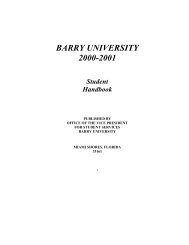The Gene Gateway Workbook
The Gene Gateway Workbook
The Gene Gateway Workbook
You also want an ePaper? Increase the reach of your titles
YUMPU automatically turns print PDFs into web optimized ePapers that Google loves.
U.S. Department of Energy Office of Science Updated: 10/05/2004<br />
Some of the features of the sequence in GenBank Record Z92910 include:<br />
source - <strong>The</strong> source feature must be included in each sequence record. <strong>The</strong> source gives the<br />
length of the entire sequence included in the record and the scientific name of the source<br />
organism. Other types of information that the submitter may include in this field are<br />
chromosome number, map location, and clone or strain identification.<br />
gene - Gives the numbers of the nucleotides where the gene stops and starts. This link<br />
opens a new sequence record that shows only the gene sequence.<br />
exon - Gives the numbers of the<br />
nucleotides where each exon begins and<br />
ends. You will see several of these entries<br />
as you scroll down. Each exon is a<br />
sequence segment that codes for a portion<br />
of processed (intron-free) mRNA. <strong>The</strong><br />
name of the gene to which the exon<br />
belongs and the exon number are<br />
provided. This link opens a new<br />
sequence record that shows only the<br />
exon sequence.<br />
CDS - <strong>The</strong> coding sequence consists of<br />
the nucleotides that actually code for the<br />
amino acids of the protein product. This<br />
feature includes the coding sequence's<br />
amino acid translation and may also<br />
contain gene name, gene product function,<br />
a link to protein sequence record, and<br />
cross-references to other database entries.<br />
This link opens a new sequence record<br />
that shows only the coding sequence.<br />
intron - Gives the numbers of the<br />
nucleotides where each intron begins and<br />
ends. An intron is a segment of noncoding<br />
sequence that is transcribed but removed<br />
from the transcript by splicing together the<br />
exons (coding portions) on either side of it.<br />
This link opens a new sequence record<br />
that shows only the intron sequence.<br />
What’s the difference between exons and<br />
coding sequence?<br />
Most texts define exons as short segments of<br />
protein coding sequence. This is a bit of an<br />
oversimplification. Exons are those segments of<br />
sequence that are spliced together after the introns<br />
have been removed from the pre-mRNA. Yes, the<br />
coding sequence is contained in exons, but it is<br />
possible for some exons to contain no coding<br />
sequence. Portions of exons or even entire exons<br />
may contain sequence that is not translated into<br />
amino acids. <strong>The</strong>se are the untranslated regions or<br />
UTRs. UTRs are found upstream and downstream<br />
of the protein-coding sequence. See diagram<br />
below.<br />
7. Examine the reference section, the features section, and the sequence at the bottom of this<br />
record, and then answer questions 2−6 of the Questions for Activity #3. Questions 7−8 will be<br />
answered using GenAtlas, which is covered in the next section of this activity.<br />
<strong>Gene</strong> <strong>Gateway</strong>: A Web Companion to the Human Genome Landmarks Poster<br />
www.DOEgenomes.org/genegateway<br />
24



